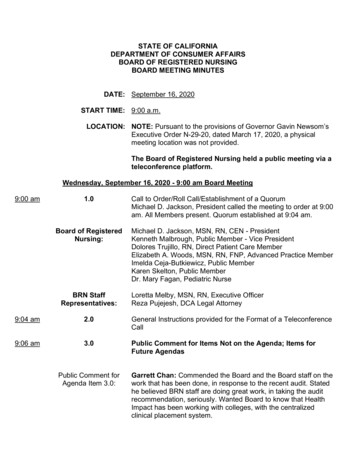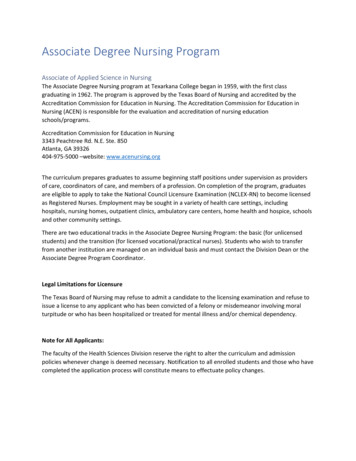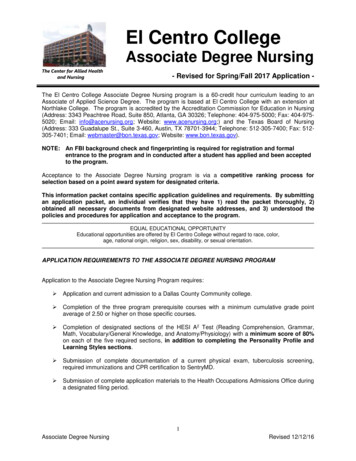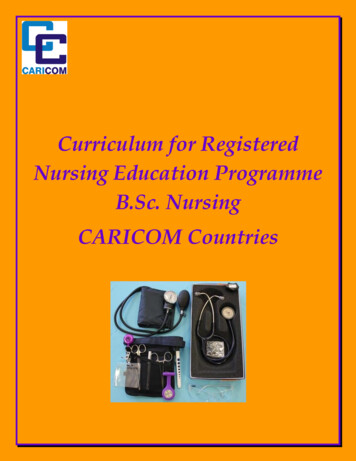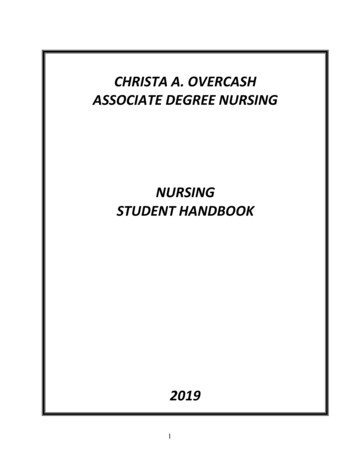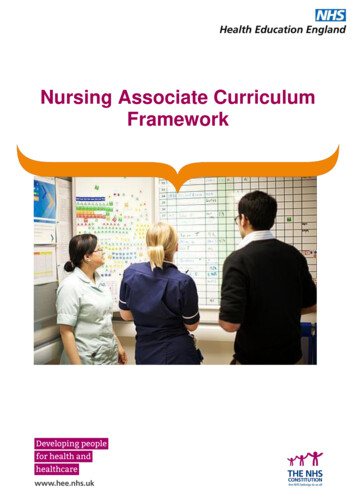
Transcription
Nursing Associate CurriculumFramework
Nursing Associate Curriculum FrameworkContentsForeword . 4Glossary . 61.Introducing the Nursing Associate Role . 12Introduction . 12The Nursing Associate Training Programme . 12The Role of the Nursing Associate . 13Background . 13Key Findings from Consultation and Engagement Events . 14Key Components of the draft parameters of practice . 14The Nursing Associate Role . 14The Development of the Curriculum Framework . 162.The Nursing Associate Training Programme . 17Programme Aims . 17Programme Approach . 17Programme Outcomes . 18Learning Outcomes from the Domains . 18Generic Characteristics of the Qualifying Nursing Associate . 19Transferable Skills Outcomes . 19Employability Outcomes . 19Career, Research, Study Skills Components . 19Programme Development and Implementation . 20Partnership Working in Developing Programmes . 20Entry Requirements . 20Employment and Placement Settings . 20Time Allocations . 22Equality and Diversity . 22Module/Unit-Based Training, Learning and Progression . 23Work-Based Learning . 232
Nursing Associate Curriculum FrameworkApproaches to Learning . 24Completion of Training . 24Supervisory Arrangements . 24Assessment on the Nursing Associate Training Programme . 25Raising Concerns on the Nursing Associate Training Programme . 263.The Nursing Associate Training Programme Domains and Learning Outcomes . 27Domain 1: Professional values and parameters of practice . 28Domain 2: Person-Centred Approaches to Care . 31Domain 3: Delivering Care . 34Domain 4: Communication and Interpersonal Skills . 42Domain 5: Team Working and Leadership . 44Domain 6: Duty of Care, Candour, Equality and Diversity . 47Domain 7: Supporting Learning and Assessment in Practice . 50Domain 8: Research, Development and Innovation . 52Appendix 1: . 55Curriculum Framework Working Group . 55Appendix 2: . 56Domains mapped to Draft Parameters of practice from Engagement events . 56Appendix 3: . 59Nursing Associate nursing and care scenarios . 59Situational Example: Nursing Home with associated care scenarios . 593
Nursing Associate Curriculum FrameworkForewordThe creation of the Nursing Associate is a landmark innovation for the nursing and care professions. Theintroduction of this new role has been welcomed by a broad spectrum of health and social carestakeholders, all of whom want a defined highly trained support role to help Registered Nurses delivereffective, safe and responsive care. The Nursing Associate will also play a key part of the multidisciplinary workforce that is needed to respond to the future needs of the public and patients.The new role will serve as a scaffolding role to enable linear and lateral career progression across thecare and nursing workforce, a key vision as part of HEE’s response to the Shape of Caring Review toensure we provide careers that are attractive and accessible.We have come such a long way since the idea of this new role was discussed in the Shape of CaringReview. From consultation and engagement on the development of the role, to inviting applications forthose wanting to deliver the education and training for the Nursing Associate, we now look forward towelcoming the first cohort of trainee Nursing Associates onto their new courses.To support national consistency and coherence in the delivery of the education and training model forNursing Associates, I am very proud to publish the national curriculum framework, developed inpartnership with Skills for Health and Skills for Care. The framework provides a benchmark for allproviders to deliver training programmes which equip Nursing Associates with the breadth of skills andprofessional competence to support Registered Nurses and other professionals to deliver high qualitycare now and in the future.Informed by the HEE consultation and subsequent engagement events earlier this year, the curriculumframework is rooted in the role’s parameters of practice. The proposals in our curriculum framework haveprovoked a vigorous and valuable national debate on what is, and what should be, within the role’sparameters of practice.We have welcomed this debate. It is right that all those working in health and social care should careabout the content of the national curriculum framework, not only because it helps to define the role, butbecause of what it says about the level 5 academic and vocational skills such a higher level critical roleshould be equipped with to benefit the public, the nursing and care workforce and the needs of achanging National Health Service.This is why we will train Nursing Associates to understand medicine’s management and, within theconfines of local employer policies, administer medicines safely and appropriately. It is an essentialrequirement for Nursing Associates to be trained and competent in this area in order that they can makea full contribution to the provision of effective care to the public and patients in primary, acute,secondary, community and social care settings – a vast care landscape. Nursing Associates must beable to work independently, within defined parameters of practice, under the direction of a registerednurse, to deliver care in line with an agreed/defined plan of care. This is planning for the future successof the NHS – in and out of hospital care, integration of health and social care, person centred care – allrequire a defined, nursing specific support role competent in delivering care functions at scale and pace.Of course, support so far has not been universal and it is absolutely right when undertaking thedevelopment of a new role such as this that we should listen to all views as we progress. It is onlythrough challenge and discussion that we improve our ideas and make the reality effective. That is oneof the reasons we held such a comprehensive consultation and why we have worked with partners andcolleagues all across the system throughout this process.I am grateful to all those organisations and individuals who have helped get us this far. The positiveresponse from across the country has been overwhelming and the support from senior nursingcolleagues across the system has been most welcome.All of this has been part of the consultation, resulting in a defined role through consensus. And of coursethe work must continue, particularly to reassure everyone that the care provided by the new Nursing4
Nursing Associate Curriculum FrameworkAssociates will be timely, appropriate and safe. We will continue to look at aspects of the role in line withrequests from our eleven test sites and we will have more to say on that soon.The national curriculum framework that we are publishing today features a number of revisions made onthe basis of evidence and arguments presented to us during the consultation and engagement periodand now reflects our aspirations that it should be rigorous and forward looking given the spectrum ofcare that this role will deliver under the supervision of Registered Nurses.I eagerly look forward to the next few weeks when our first 1,000 students will begin their trainingprogrammes.Professor Lisa Bayliss-PrattDirector of NursingDeputy Director of Education and QualityHealth Education England5
Nursing Associate Curriculum FrameworkGlossaryThe purpose of this glossary is to aid clarity and understanding, and help in the creation of NursingAssociate Training Programmes. It draws on well-established glossaries in nursing, health and socialcare. Most of the terms defined in the glossary are highlighted in bold text on the first mention in ility is to be responsible for the decisions you make and beanswerable for your actions.AdvocateA person, group or organisation that supports and champions individuals orgroups, ensuring that their views are considered and their rights upheld.Agreed ways of workingWill include policies and procedures where these exist and apply. There maybe less-formal documents among individual employers.Alternative settingsThose workplace settings that form 'external placements', namelyplacements that offer settings other than those in the training nurseassociate's primary placement.Approved educationinstitution (AEI)A higher education institution recognised by the Nursing & Midwifery Council(NMC) as a provider of NMC-approved programmes which lead toregistration or a mark on the register, and preparatory programmes forindividuals who will support learning and assessment in practice.Assessment (of and forlearning)Involves collecting and analysing evidence for use by learners and trainers todecide where the learners are in their learning, where they need to go andhow best to get there.Assign/assigningThe handing over of responsibility and accountability of specific tasks orareas of work (see Delegation).AutonomyThe freedom to make binding decisions, within the parameters of practice,based on professional ethics, expertise and clinical knowledge.Care and supportCare and support enables people to do everyday things such as: get out ofbed, get dressed and go to work; cook meals; see friends; care for families;and be part of our communities. It might include emotional support at a timeof difficulty or stress, or helping people who are caring for a family member offriend. It can mean support from community groups or networks, for example,giving others a lift to a social event. It might also include state-fundedsupport, such as information and advice, support for carers, housing support,disability benefits and adult social care.6
Nursing Associate Curriculum FrameworkCarerAn individual providing personal care for a person or people who, due toillness, infirmity or disability, are unable to care for themselves without thishelp (adapted from Care Standards Act 2000).CommunicationThis includes verbal and non-verbal communication such as signs, symbols,pictures, writing, objects of reference, human and technical aids, eye contact,body language and touch. Communication may happen using a variety ofmethods, such as face to face, by telephone, email, text, via social networks,written reports and letters.CompassionDescriptions of compassionate care include: dignity and comfort; taking timeand patience to listen, explain and communicate; demonstrating empathy,kindness and warmth; care centred around an individual's needs, involvingpeople in the decisions about their healthcare, care and support.CompetenceThe overarching set of knowledge, skills, attitudes and behaviours requiredto practice safely and effectively within the parameters of practice.CompetentHaving the necessary ability, knowledge, skills and attitudes to do somethingsuccessfully.Constructive feedbackFeedback that addresses both positive and negative considerations,expressed in a way that encourages reflection and changeContextContext refers to the particular sector of healthcare, for example, primary,acute care, and so on.Continuing professionaldevelopment (CPD)The way a worker continues to learn and develop throughout their careers,keeping their skills and knowledge up to date and ensuring that they canwork safely and effectively.Cultural competence"The ability to maximise sensitivity and minimise insensitivity in the caring forand working with culturally diverse communities. This requires knowledge,values and skills but most of these are the basic knowledge and skills whichunderpin any competency training in numerous care professions. Theirsuccessful application in work with diverse people and communities willdepend a great deal on cultural awareness, attitudes and approach. Theworkers need not be, as is often assumed, highly knowledgeable about thecultures of the people they work with but must approach culturally differentpeople with openness and respect – a willingness to learn. Self-awareness isthe most important component in the knowledge base of culturally competentpractice." (O'Hagan, 2001, p235)7
Nursing Associate Curriculum ng people who use social care, their families and carers asequal partners in decision-making, recognising that people who usesupport services and their families have expertise that can be used tohelp make services better for themselves others too.Can include research, reports, statistics, internal and external feedback,regulatory feedback, appraisal, suggestions, individuals' records, complaintsetc.The handing over of specific tasks or areas of responsibility while retainingaccountability for those tasks/areas of work.Covers all aspects of daily life, including respect, privacy, autonomy and selfworth. While dignity may be difficult to define, what is clear is that peopleknow when they have not been treated with dignity and respect. Dignity isabout interpersonal behaviours as well as systems and processes.DiversityCelebrating difference, valuing people and recognising them for their skills,talents and experiences, accepting that everyone is different and respectingthose differences. (See also Equality.)Duty of careDuty of care is the legal obligation to: 1) Always act in the best interests ofindividuals and others; 2) Not act or fail to act in a way that results in harm;3) Act within your competence and not take on anything you do not believeyou can safely do.EqualityExternal placementHolisticInclusion/InclusiveTreating everyone fairly and providing equal opportunities for everyoneregardless of their race, gender, disability, age, sexual orientation, religionand belief.Refers to those placements of the training nursing associate in work settingsother than their primary placement.Concerning the whole person. A holistic approach to nursing considersphysical, social, economic, psychological, spiritual and other factors whenassessing, planning and delivering care.Ensuring that people are treated equally and fairly and are included as partof society.8
Nursing Associate Curriculum FrameworkIndividualThe person using or requiring the health, care or support service.InformationInformation may include journals, internet/websites, publications, legislation,and professional bodies.Integrated careCo-ordinated health and social care that is planned and organised aroundthe needs and preferences of the individual, their carers and family.Integration may extend to other services, for example housing, that can offerholistic approaches to address individual circumstances.Learning outcomesStatements of learning which trainees must achieve to demonstrate that allprogramme competencies and requirements have been met.Nursing AssociateThe nursing associate is a new role arising out of recommendations of aseries of reports and policy documents. The nursing associate will beequipped with the knowledge, skills and behaviours what will enable them tosupport the delivery of nursing care, in and across a wide range of healthand care settings. Under the leadership and direction of registered nurses,they will work within all aspects of the nursing process to provide highquality, holistic and person-centred care to individuals and will support theregistered nurse in the assessment, planning and evaluation of care.Parity of esteemValuing mental health equally with physical health.Programme providerThe term used to describe approved education institutions (AEIs) and theirpartnering practice learning providers.ResponsibilitySafeguardingResponsibility is used in connection with tasks or areas of work that havebeen assigned to an individual or individuals. Responsibility means that theindividuals are expected to carry out those tasks, and that they are theowners of a task, event or area of work. Responsibility differs fromaccountability in that responsibility can be shared but accountability cannot.Being accountable means not only being responsible for something butultimately being the person answerable for actions takenSafeguarding in the context of healthcare regulation means acting in the bestinterests of people when they are using or needing the services of nursesand midwives. It also has a wider meaning outside healthcare regulationwhich relates to protecting children, young people and vulnerable adults fromabuse and neglect, but also actively promoting their welfare.9
Nursing Associate Curriculum FrameworkSelf-careSelf-care is personal health maintenance. It is any individual, family orcommunity activity that aims to improve or restore health, or treat or preventdisease. It includes all health decisions people make for themselves andtheir families.SettingAny environment where care is delivered. This includes hospitals, communityservices and general practice, individuals' own homes, care and residentialhomes, workplaces.Supervision (direct andindirect)Direct supervision is where the trainee must be in the line of sight of thesupervisor who is present to observe tasks and activities and can interveneimmediately if required. Indirect or remote supervision is where there is areliance on processes being in place to provide guidance and supportwithout the supervisor actually being present.SupervisorA suitably prepared professional trained to support students in practice thatmeets Nursing & Midwifery Council (NMC) requirements.Technology/technologiesThe application of scientific knowledge for practical purposes in health cancare settings and/or machinery and devices developed from scientificknowledge for use in health and care settings. Encompasses simulationtechnologies, mobile technologies, digital technologies, assistivetechnologies, and so on.Trainee Nursing AssociateSomeone who is enrolled on a Nursing Associate Training Programme.Unconditional positiveregardUnconditional positive regard means accepting and respecting others as theyare without judgement or evaluation.Unwarranted variationUnwarranted variations are those variations in health and care that can bechanged if we choose to. They can be a sign of poor-quality care, missedopportunities and waste, and can result in poorer outcomes, poorerexperience and increased expense.Work-based learningCan be learning through work, learning for work and learning at work or amixture of all three.Work settingMay refer to one specific location or a range of locations, depending on thecontext.10
Nursing Associate Curriculum FrameworkSources:Nursing & Midwifery Council, Standards for Pre-registration Nursing Education; 2010. Available cation.pdfSkills for Care, Level 5 Diploma Leadership and Management for Adult Care; 2016. Available nd-Management-Adult-Care.pdfSkills for Care and Skills for Health, Code of Conduct for Healthcare Support Workers and Adult SocialCare Workers in England; 2013. Available at: .pdfO’ Hagan K, Cultural Competence in the caring professions; 2001. Jessica Kingsley Publishers, London.11
Nursing Associate Curriculum Framework1. Introducing the Nursing Associate RoleIntroductiona) This curriculum framework document sets out what knowledge, understanding, skills, attitudesand behaviours a trainee nursing associate will have developed on successfully completing anursing associate1 qualification at academic Level 5.2b) It is intended to set out a curriculum framework for approved educational institutions (AEI)from which they can develop specific programmes.c) For ease and clarity, this curriculum framework will be referred to through this document as theNursing Associate Training Programme, even though it is recognised that the document does notset out a full programme. Rather, it presents guidance for programmes that AEIs will derive fromit, acknowledging that there will be a number of specific programmes derived from thisframework.d) This curriculum framework presents the overall aims and the learning outcomes expected ofany derived programmes.e) This document will be subject to regular review with first and particular focus on review during thepilot phases of the programmes.The Nursing Associate Training Programmea) The programme combines academic and work-based learning through close collaborationbetween employers and education providers. As an employee, a trainee nursing associate will bebased in a particular organisation in a specific setting. But they will also experience working inalternative settings to gain a wide appreciation of many health and care environments to fulfil allthe requirements of the programme. At the end of the programme, the trainee will be equippedwith the knowledge, understanding, skills, attitudes and behaviours relevant to employment as anursing associate. The trainee will work to a nationally recognised code of conduct that will bedeveloped during the test phase of the Nursing Associate Training Programme.b) The programme is intended as a standalone qualification at academic level 5, but will alsoprovide the basis for further, lifelong study and progression into higher-level qualifications.c) The Nursing Associate Training Programme has been developed to provide an outcome-basedprogramme of academic and work-based learning that will develop the wide-ranging skills andcapabilities required in this new role.d) The programme builds on the traditions, experience and values of a progressive profession thataims to provide the highest-quality, person-centred care in the 21st century. In a fast-pacedworld of change, the programme places compassionate care at its core while promoting theenthusiastic adoption of the technologies and innovations that support service improvements.1Terms in bold are defined in the glossary at the start of this document2It is expected that the programme will offer 120 credits at Level 4 in Year 1 and a further 120 credits at Level 5 in Year 2.12
Nursing Associate Curriculum Frameworke) The programme emphasises the role that nursing associates can play in a life-course(preconception to end of life) approach to health and wellbeing and their active contribution todelivering holistic care. Holistic care is a whole-person approach that, in assessing, planningand delivering care, considers and equally values:3f) physical needs psychological needs public health needs learning disabilities needs and considerations social, economic, spiritual and other factorsThe programme aims to produce nursing associates who are fit to practice in the widest range ofsettings. It equips trainees with the specific knowledge, skills and capabilities required for thecontext of their training and employment.The Role of the Nursing AssociateBackgrounda) The Shape of Caring Review4, published in March 2015, made a series of recommendations tostrengthen the capacity and skills of the nursing and caring workforce. One key recommendationwas to explore the need for a defined care role to act as a bridge between the unregulated careassistant workforce and the registered nursing workforce.b) In the autumn of 2015, Health Education England (HEE) engaged widely with individualsreceiving care, carers, health and care professionals, trade union representatives, Skills forHealth, Skills for Care and nurse leaders to explore the Shape of Caring Review findings.c) In December 2015, the HEE Executive approved the recommendations and the governmentannounced a plan to create a new nursing support role for England. HEE was asked to consulton this new role.d) HEE undertook a six-week public consultation on the proposal to introduce a new nursingassociate role to support the registered nurse workforce in providing high-quality person-centredcare across health and social care settings.5 The consultation generated important perspectiveson the skills, competencies, portability and deployment of the proposed role. HEE received 1,384responses to the consultation: 1,129 from individuals and 255 from organisations. Mostrespondents supported the development of the role. HEE’s response to the public consultationwas published in May 2016. At the same time, HEE published its response to the Shape ofCaring Review engagement activity.3It is vital that training emphasises parity of esteem – that is, valuing mental health equally with physical health.4HEE, Shape of Caring Review; 2015. Available at: ce/nursing/shapecaring-review5HEE, Building Capacity to Care and Capability to Treat: A New Team Member for Health and Social Care in England; 2016.Available at: nse to Nursing Associate consultation 26 May 2016.pdf13
Nursing Associate Curriculum Frameworke) In June 2016, HEE issued an open call for partnership applications to run two-year test sites forthe training of the first cohort of 2,000 trainee nursing associates.f)After analysing the results of the public consultation, in July 2016 HEE held a series of one-dayengagement events across the country. Participants from a wide range of roles, qualificationlevels and experience, geography and organisations worked to clarify the parameters of the role.Five engagement events were held in Birmingham, London, Manchester, Newcastle andReading, with an average of 110 participants at each.
Nursing Associates, I am very proud to publish the national curriculum framework, developed in partnership with Skills for Health and Skills for Care. The framework provides a benchmark for all providers to deliver training programmes which equip Nursing Associates with the breadth of skills and .
